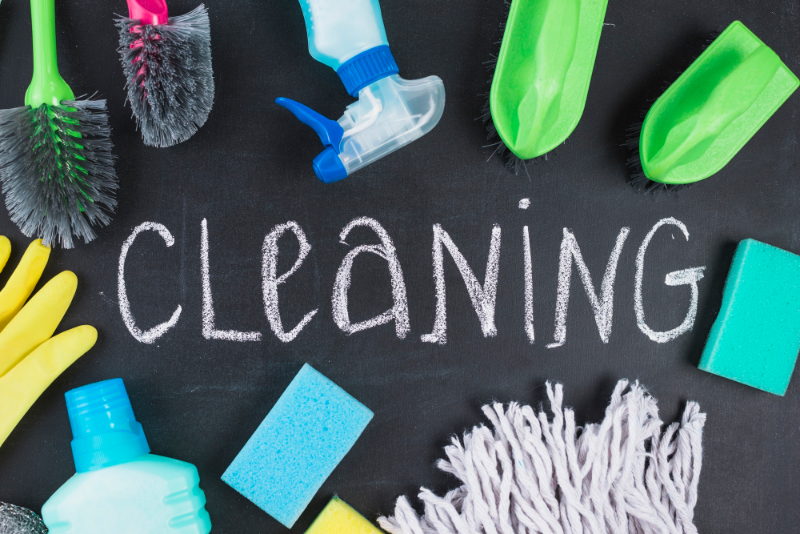How to Master Everyday Cleaning: Tips for Effective Defrosted and Cleaned Every Few Months and Decluttering
How to Master Everyday Cleaning: Tips for Effective Defrosted and Cleaned Every Few Months and Decluttering
Blog Article
Understanding the Requirement for Extensively Disinfecting and Sterilizing Often Touched Surfaces in High-Traffic Areas
In the realm of public health and wellness and safety and security, the meticulous disinfection and sanitization of frequently touched surfaces in high-traffic locations stand as extremely important steps in avoiding the spread of unsafe virus. The importance of this practice prolongs much past mere cleanliness, delving right into the realm of illness avoidance and area wellness. By checking out the numerous elements of surface area sanitation, from the threats connected with overlooking cleaning protocols to the reliable techniques that can be employed, a more clear understanding arises of the vital role these techniques play in safeguarding public health. As we browse this conversation, it becomes obvious that the ramifications of detailed surface area sanitation resound not only within the confines of a particular setting but additionally resonate on a more comprehensive range, affecting the health and security of individuals across diverse communal settings.
Importance of Surface Sanitation
Emphasizing the detailed sanitation of high-traffic surface areas is essential in maintaining a sanitary environment and protecting against the spread of damaging microorganisms. High-touch surfaces such as door handles, light buttons, lift buttons, and countertops function as reproducing grounds for germs and infections. Normal disinfection of these surface areas is imperative to minimize the threat of contamination and transmission of illnesses.
By applying a robust sanitation procedure, services and institutions can create a more secure atmosphere for consumers, site visitors, and employees. Correct surface area disinfection not just minimizes the spread of contagious diseases yet also instills self-confidence in the sanitation and safety of the facilities. This positive approach shows a commitment to health and wellness and wellness, which is particularly crucial in high-traffic locations where the likelihood of exposure to virus is heightened.
Additionally, surface area sanitation plays a crucial function in overall infection control methods. Incorporated with hand hygiene methods, wearing masks, and keeping physical distancing, thorough sanitation of high-touch surface areas forms an extensive defense versus the transmission of unsafe bacteria. Prioritizing surface area disinfection is an important element of an all natural technique to health and wellness in shared rooms.
Threats of Neglecting Cleansing Practices
Ignoring extensive disinfection of high-traffic surfaces dramatically enhances the risk of viral and microbial contamination, posturing a serious danger to the wellness and safety of individuals often visiting these rooms. Failure to carry out proper cleansing techniques can result in the accumulation and spread of dangerous pathogens, including bacteria and viruses, on frequently touched surfaces such as doorknobs, handrails, lift switches, and counter tops.

Additionally, disregarding the significance of complete cleaning not only compromises the health of people but also threatens initiatives to preserve a tidy and hygienic atmosphere. It is essential to recognize the relevance of proper disinfection procedures in avoiding the spread of infections and guarding public wellness.
Reliable Disinfection Approaches
To keep ideal cleanliness and decrease the danger of contamination on high-traffic surface areas, employing effective disinfection approaches is essential. Among the most effective and usual disinfection techniques is using chemical anti-bacterials. These items can vary in stamina and composition, with some targeting certain pathogens like infections or germs. It is important to follow the maker's guidelines for appropriate dilution, call time, and air flow when utilizing chemical anti-bacterials to guarantee their effectiveness - defrosted and cleaned every few months.
An additional effective technique is using UV-C light. UV-C light has been revealed to be reliable in eliminating a wide selection of bacteria by interrupting their DNA framework, thus preventing them from duplicating. Nevertheless, it is vital to use UV-C light properly, making certain that the correct strength and direct exposure time are related to attain the wanted disinfection results.
Additionally, employing vapor cleansing as a disinfection technique can be extremely reliable, particularly on surfaces that are heat-resistant. Vapor can permeate porous surfaces and kill microorganisms, viruses, and various other pathogens properly. When using heavy steam cleaning, it is essential to make sure that the surface gets to the required temperature for an enough amount of time to assure correct sanitation.
Influence On Public Wellness
The upkeep of high standards of tidiness and disinfection on high-traffic surfaces plays a vital duty in securing public health and wellness. Regularly touched surface areas in areas with high step, such as doorknobs, handrails, elevator switches, and bathroom centers, serve as reproducing premises for dangerous virus.
In high-traffic areas like airports, colleges, health why not check here centers, and public transport systems, the impact of strenuous sanitation steps can not be underrated. Focusing click on the sanitization of often touched surfaces is a positive approach to advertising public health and wellness and enhancing the security of individuals in shared spaces.
Implementing Normal Cleaning Protocols
Quickly instituting and sticking to a regular routine of cleaning procedures is vital for maintaining the sanitation and safety and security of high-traffic surface areas. Normal cleansing procedures are important in avoiding the accumulation of bacteria and microorganisms on regularly touched surfaces, specifically in locations with high foot web traffic. By carrying out an organized technique to cleansing, companies can efficiently reduce the threat of illness transmission and create a much healthier atmosphere for employees, consumers, and the general public.
To establish a reliable cleansing routine, it is essential to determine high-traffic areas that require frequent attention. These areas might consist of doorknobs, handrails, elevator buttons, toilet centers, and common devices. Implementing a routine cleaning routine that targets these surface areas several times a day can dramatically decrease the spread of hazardous microorganisms and viruses.
Additionally, using suitable cleaning representatives and disinfectants is essential to making certain that surfaces are extensively sanitized. Normal training of cleansing team on correct cleaning techniques and the value of adherence to the cleansing schedule is additionally vital in keeping a sanitary setting. By focusing on consistent cleansing methods, organizations can advertise the health and well-being of individuals that connect with these high-traffic surface areas.

Final Thought
In verdict, it is important to prioritize thorough disinfection and sanitization of regularly touched surfaces in high-traffic areas to stop the spread of unsafe virus and preserve public health. It is crucial to acknowledge the value of maintaining tidy surface areas in high-traffic areas to make sure the wellness of the community.
In the realm of public wellness and safety and security, the thorough disinfection and sanitization of regularly touched surfaces in high-traffic locations stand as paramount actions in stopping the spread of hazardous pathogens. By discovering the various facets of surface area sanitation, from the dangers associated with neglecting cleansing protocols to the reliable approaches that can be employed, a more clear understanding arises of the crucial function these techniques play in guarding public health and wellness.In addition, employing heavy steam cleansing as a disinfection approach can be very reliable, specifically on surfaces that are heat-resistant. When using heavy steam cleaning, it is important to ensure that the surface gets to the needed temperature for an adequate quantity of time to ensure appropriate sanitation.
In conclusion, it is essential to prioritize comprehensive sanitation and sanitization of frequently touched surface areas in high-traffic locations Visit Your URL to avoid the spread of hazardous virus and preserve public wellness.
Report this page